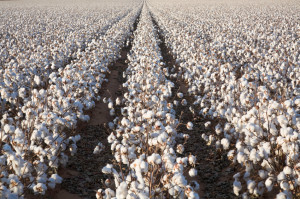Weak US, EU Economies to Hinder Clothing and Textile Sales

The well-documented struggles in the global economy, particularly in the United States and European Union, are dragging down business and consumer confidence and will lead to a drop in demand for clothing and textiles, according to Textiles Intelligence.
Unfortunately, that decrease in demand is expected to hit cotton harder than its synthetic competitors, meaning it’s not only the market that’s shrinking, but also cotton’s share of it. “I think that demand for cotton apparel will fall at a faster rate than demand for total apparel over the whole of 2012,” Guillaume Brocklehurst, trade analyst with Textiles Intelligence, a UK-based global business information company, told Cotton International. “Fabric producers are reporting slower sales of cotton fabrics as cotton prices continue to fluctuate and prices remain uncertain and, as a result, alternatives are being used – a popular choice being cellulose fibers such as viscose and lyocell.”
Some of the impact is already being seen: In the first five months of 2012, U.S. cotton apparel imports fell 12% while those for manmade fiber apparel imports rose 8%.
In the EU, the economic recovery that started in 2010 is expected to be snuffed out in 2012. Forecasts suggest that the EU economy will suffer a second dip in 2012 with GDP down 0.5% in real terms. A partial recovery is predicted for 2013, but GDP is expected to grow by a mere 0.8%.
The views of European textile manufacturers reflect this outlook. Having reported a notable recovery in their markets in 2011, the recovery slowed markedly in the last quarter of the year and the view now is that the effects of Europe’s economic turbulence will continue to have an adverse effect on trade during the remainder of 2012, and perhaps beyond. Indeed, in the first quarter of 2012, EU clothing imports were down in volume by a dramatic 12%.
The prospects for the United States are less pessimistic. In 2012, GDP growth is expected to accelerate to 2.2%, from 1.7% in 2011, before falling back slightly to 2.1% in 2013. Nevertheless, clothing imports continue to be affected, with the volume of imports in the first quarter of 2012 down 3.9%.
Weak market conditions in the EU and the US affected exports from several Asian countries in the first quarter of 2012, following strong growth in 2011 as a whole. In Indonesia, for example, textile and clothing exports rose 18.2% in value in 2011 but fell 5.2% in the first quarter of 2012. In Thailand, exports rose 7.5% in value in 2011 but declined by a sharp 15.3% in the first quarter of 2012. And in the Philippines, clothing export growth slowed in value to just 1.1% in the first quarter of 2012 after an 11.4% increase in 2011. Export growth also slowed in several other countries.
In India, meanwhile, clothing exports fell in value by a sharp 11.9% in the 2011/12 financial year, which ended on March 31, 2012, having increased 4.7% in the previous year. Textile export growth slowed to just 0.4%, having risen 34.7% in 2010/11.
Reflecting the country’s weaker export prospects, Indian GDP growth forecasts for 2012 have been revised downward. In September 2011, it was predicted that India’s GDP would grow 7.5% in 2012, but in April 2012, this forecast was revised downwards to 6.9%. Furthermore, in the first three months of 2012, Indian GDP rose only 5.3%, which represented the slowest quarterly growth rate in India in the last nine years.
The prospects for China — which has long been an engine of growth for the world economy — are similar, with GDP growth forecasts lowered from 9% to 8.2%.
As a result, global GDP is expected to grow by only 2.1% in 2012 after increasing 2.5% in 2011 and 4.1% in 2010.
Emerging markets and, in particular, the so-called BRIC countries — Brazil, Russia, India and China — will continue to be the key to sustaining global trade growth over the coming years.
In India, for instance, the domestic market for textiles and clothing is expected to increase 169% in value over the 10-year period between 2010 and 2020, from an estimated $52 billion to $140 billion.
If there is a silver lining for cotton, Brocklehurst says, it’s that things might improve in the coming months.
“Some experts believe that by September 2012, the surge in cotton prices that occurred up to March 2011 will have passed through the entire supply chain, and that prices for cotton apparel will become more competitive,” he says.









